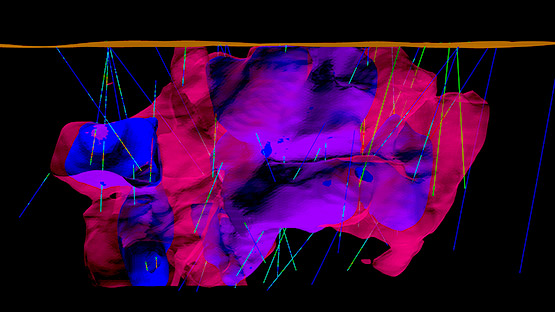Vulcan 2024
Plot Builder Enhanced
Improved view synchronisation between the Vulcan view window and Plot
Builder. Saved views in Vulcan are now accessible through Plot Builder by
default.
Vulcan Data Analyser Enhanced
When generating variograms from normal score transformed data, both the
resultant variogram model and experimental variogram can now be
backtransformed, simplifying the workflow and providing an easier path to
the expected result.
Vulcan Gantt Scheduler Enhanced
Improvements to the Column Order Manager user interface enable faster custom
column layout creation for better navigation in the Gantt chart.
Triangulations Performance
Vulcan triangulations will now load twice as fast on average.
Automated Pit Designer New
Automate workflows with the new external Automated Pit Designer executable.
Drill and Blast Enhanced
More controls for moving open pit blast holes.
Vulcan Python API Enhanced
New methods added to provide better manipulation and handling of screen
objects.
Grade Estimation Performance
Improved performance for estimations to better leverage processors with more
than 64 cores.
File Import and Export Improved
Better export performance for DWG/DXF when using ICF tables.
Local caching New
Full local caching for design databases significantly improves stability and
performance of various tools.
Colour palette Enhanced
Standardisation on 256-colour palette enhances stability for users, with
backwards compatibility maintained.
Performance Improved
Simulations and post-simulation executables now perform significantly
better.
ICP reporting Enhanced
Improved panel allows for updated report sorting method and three priority
levels for sorting. Reporting for cuts and breakdowns pages supports both
polygon and triangulation input.
Labs menu New
Menu and options for experimental tools now available, based on relevant
licensing.
Streamlined stratigraphy New
Guided workflow for creating surfaces and modelling output available under
Labs
menu.
Reserving New option in
APD
Results are now displayed in a dynamic panel after reserves are run from the
main interactive panel in Automated Pit Designer.
Pit topography Enhanced
Additional output settings improve reporting and downstream planning.
Import to CSV Enhanced
Users now have greater control over specification files and filing location
with
an improved specification panel.
Reserving New option in
ICP
Increased functionality for reserves in Interactive Cut Planner allows users
to
gain immediate feedback on design and scheduling cut material.
Triangulation files Enhanced
Users can expect improved performance when working with large triangulation
files due to reduced system memory usage.
Compliance Enhanced
Improved filtering, including minimum thickness filter to reduce the noise
produced by largely coincident surfaces results in cleaner output data.
Statistics based domains New
Rules that define custom domains in Vulcan Data Analyser can now be output
to
scripts for coding blockmodels and databases.
Sequential Gaussian Simulation Enhanced
Simulations that have sample selection now run in reduced time.
Grade capping Enhanced
workflow
Dynamically apply grade capping in Vulcan Data Analyser as a transformation
to
use in variography and statistics. Capping values can also be read from
block
model variables in grade estimation.
Colour triangulation by attributes Enhanced
Colour triangulations with static legend to quickly understand the data.
Improved
workflow removes the guesswork behind
attribute value ranges for faster process.
Interactive Cut Planner Enhanced
Quick Mode panel now seamlessly supports Advanced Reserves specification
files,
simplifying configuration for a more
intuitive and efficient planning process.
Grade Control attributes New
Calculation rule for attributes now includes time variables for easier, more
precise
calculations and reconciliation.
Drillhole collar symbols Enhanced
Take advantage of drillhole collar symbols when loading drillholes, for a
more
comprehensive view of geological data.
Variogram display New
New variogram display selection in Vulcan Data Analyser for easily
distinguishing
between variograms, improving
confidence regarding tolerances, range and direction applied for specific
studies.
Swath plotting Enhanced
Swath Plot spatial graphs in Vulcan Data Analyser now include a feature that
averages the points on the graph, offering
a dynamic option for spacing between each point on every analysed axis.
Vulcan Data Analyser User
Experience
Drag and drop functionality makes it easy for users to add variables to
charts
for
quick comparisons.
Gaussian tools Enhanced
Vulcan Data Analyser now allows users to execute transformations and
simulations
in
Gaussian space as command files for
more efficient workflow.
Geotechnical tools Enhanced
Scale geotechnical structures based on fields in your database, allowing for
quick
identification of important
structures.


